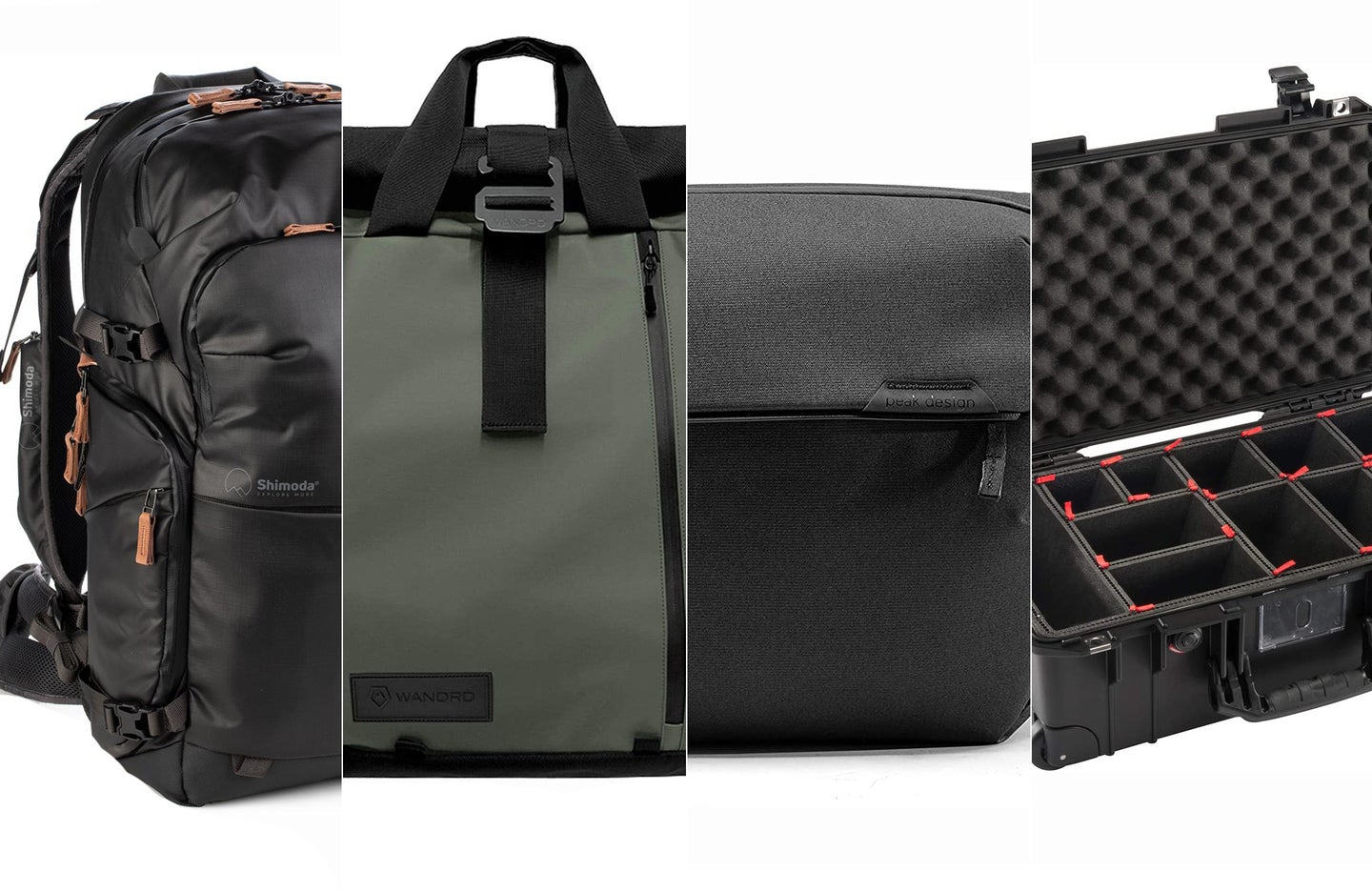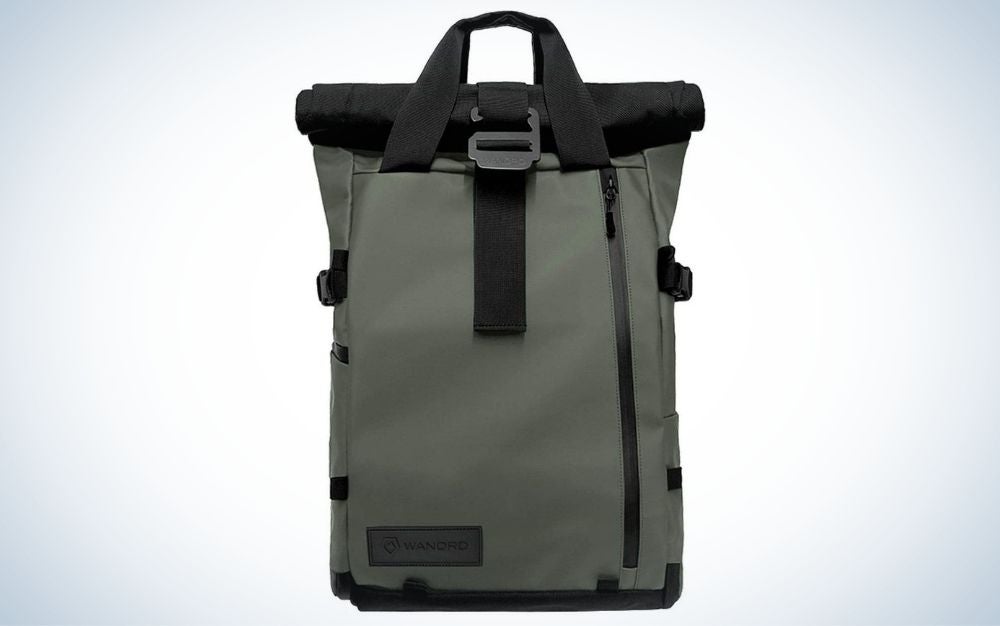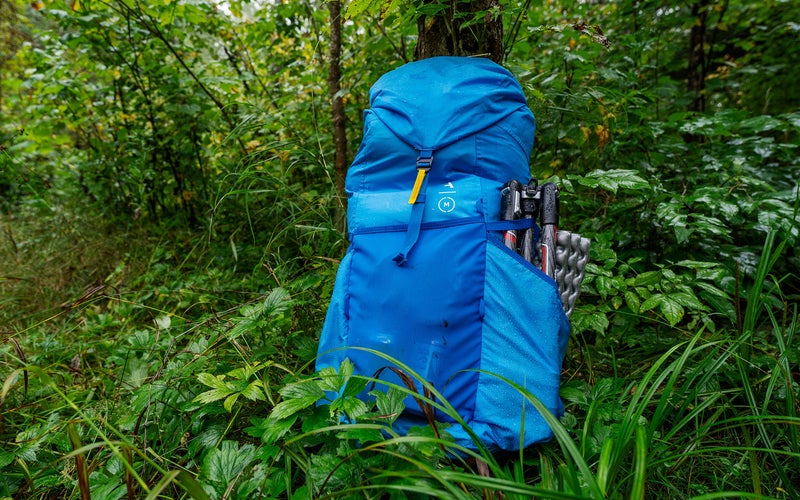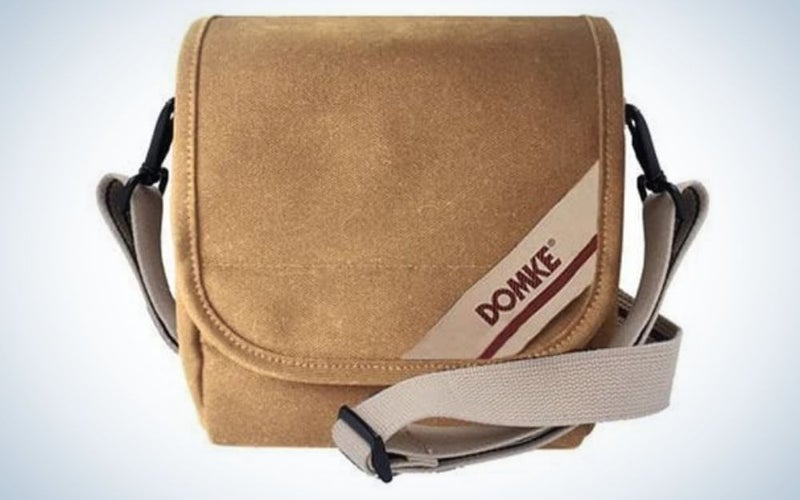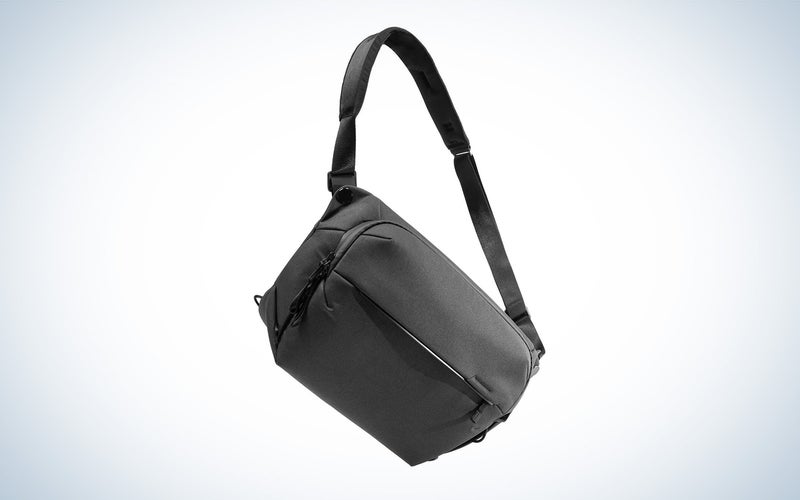We may earn revenue from the products available on this page and participate in affiliate programs. Learn more ›
One excellent way to keep your gear safe when on the go is to invest in quality camera bags for travel. They truly are an essential piece of your photography kit. Being able to confidently carry your equipment no matter where your travels take you can open new creative doors and allow you to photograph even more. Whether you are hopping on a plane, going on a road trip, or simply spending the day exploring your own city, having a dedicated bag to store and carry your equipment makes a big difference. Travel cases for cameras not only keep your expensive gear safe from the inevitable jostling around of travel, but they can also help you stay organized and save you some headaches when away from home. We’ve picked these outstanding options as the best camera bags for travel.
- Best overall: WANDRD PRVKE
- Best rugged: Shimoda Explore V2
- Best for hiking: Moment Strohl Mountain Light
- Best belt bag: Domke 5XA
- Best sling bag: Peak Design 10L Everyday Sling V2
- Best roller bag: Manfrotto Pro Light Reloader Switch-55
- Best protection: Pelican Air 1615
How we chose the best camera bags for travel
When selecting the bags in this guide, we considered choices from well-trusted brands, a wide variety of styles, and bags suitable for several different travel scenarios. We also put thought into the different amounts and types of gear that a photographer or videographer might need to bring along with them while traveling. For example, it was critical to include bags suitable for long-haul trips with lots of gear and more suitable options for day trips around a new city with more basic camera equipment. It was also important to only include items and brands that we’ve had experience using in the field or tested as part of a product review.
The best camera bags for travel: Reviews & recommendations
Best overall: WANDRD PRVKE
WANDRD
Specs
- Color options: Black, Aegean Blue, Wasatch Green, Yuma Tan, Sedona Orange
- Laptop sleeve: Yes, up to 16 inches
- Exterior dimensions: 19 x 12.5 x 7.5 inches
- Weight: 3.4 lbs
- Bag type: Backpack
Pros
- Durable, waterproof build
- Multi-use, versatile bag
- Lots of organization pockets for personal items
Cons
- Camera cube must be purchased separately
The WNDRD PRVKE is one of our favorite camera backpacks on the market—a versatile choice for traveling that’s accompanied us on many out-of-town shooting trips. It can hold a lot of gear while doing an excellent job of distributing weight. The dedicated camera cube and laptop sleeve make it easy to travel through airport security, and its many pockets are great for keeping personal items organized as well. The roll-top design allows you to expand its carrying capacity by five full liters, making it easy to toss a jacket or other essentials on top. And it has clever travel-friendly features like a key clip and a passport pocket.
A left-side pocket makes it easy to access your camera without removing the bag from your body, which is useful when you are on the go. The abrasion-resistant and waterproof material of the bag will keep your gear safe and dry, an ideal feature for the best camera bag for travel. It’s available in 21L and 31L, or if you are looking to carry less, you can check out the PRVKE Lite, which is 11L. If you are traveling with minimal camera equipment, you PRVKE the best camera bag for travel.
Best rugged: Shimoda Explore V2
Mason Marsh
Specs
- Color options: Black, Olive Green
- Laptop sleeve: Yes, up to 16 inches
- Exterior dimensions: 11.6 x 20.3 x 6.7 inches
- Weight: 8.8 pounds
- Bag type: Backpack
Pros
- Adjustable torso height
- Water-resistant
- Meets EU and Asian carry-on requirements
- Removable camera cube
- Also available in 25 or 35L sizes
Cons
- Pricey
Shimoda designed the Explore V2 with the idea that different people need different bags, and what’s comfortable for one person won’t work for everyone. To do this, they created the ability to adjust the torso height of the bag, a unique feature that will make it more comfortable to carry for different torso lengths. Plus, Shimoda sells different strap types to accommodate different bodies. The backpack also comes in three different sizes (25, 30, and 35L), with the 30L able to hold a medium mirrorless camera or a compact DSLR.
Built with travel in mind, the Explore V2 meets the strictest requirements of EU and Asian carry-on rules. Plus, it has a luggage passthrough, lockable zippers, a passport pocket, and a dual-access document sleeve. In addition, it has pockets on both sides for stashing a tripod and water bottle and multiple access points for camera equipment—including side access.
The bag features highly weather-resistant material and YKK AquaGuard zippers, so your gear will stay dry if you get caught in a brief rain shower. It also comes with a rain cover for more severe downpours. The Shimoda’s Explore V2 is one of the best camera bags for travel when you’ll find yourself exploring the outdoors with your camera. We liked it so much, we gave it a Pop Award as one of the best pieces of gear around.
Best for hiking: Moment Strohl Mountain Light
Abby Ferguson
Specs
- Color options: Black or Blue
- Laptop sleeve: None
- External dimensions: 31.5 x 10.5 inches
- Weight: 2.6 pounds
- Bag type: Backpack
Pros
- Holds a lot of gear beyond camera equipment
- Compatible with water bladders
- Durable and waterproof
- Collapses down for packing
Cons
- Doesn’t hold much camera gear
If your travels are taking you on longer hikes that require more gear than just a jacket and some snacks, the Moment Strohl Mountain Light is a fantastic choice. It comes in two different torso lengths—17-18.5 inches and 18+ inches— so you can get a better-fitting bag for your body. And there are plenty of straps to adjust the fit once it’s on.
This hiking camera bag is a stuff sack style with a small camera compartment at the bottom. You’ll either need to buy the MTN Light Camera Insert or use your own internal camera unit (ICU). It’s important to note that this bag isn’t meant to hold a ton of camera gear. Instead, it’s for those who want to travel light and fast or are prioritizing hiking and camping gear over cameras. But, with the addition of the Camera Loader, you’ll get a little extra room and faster access to your camera.
One of the biggest selling points is how lightweight this camera backpack is. It weighs just 2.6 pounds when empty. And the internal frame is removable if you want to cut down on weight even more. It packs down super small, so you can easily toss it in your luggage to use on longer trips. The pack is compatible with a hydration bladder and can expand a lot, making it capable of holding lots of gear when you need it to. I went on a two-day backpacking trip with it and was able to carry everything I needed, and it was still relatively comfortable.
Best belt bag: Domke 5XA
Domke
Specs
- Color options: Black
- Laptop sleeve: None
- Exterior dimensions: 8 x 8 x 4.5 inches
- Weight: 1 pound
- Bag type: Shoulder/belt
Pros
- Can be worn on a belt or as a shoulder bag
- Compact, lightweight option
- Durable canvas build
Cons
- Doesn’t fit large DSLRs or long lenses
Domke is a classic camera brand if you are looking for an inconspicuous bag for a small camera body. This particular version can be worn over your shoulder or attached to your belt—making it a great choice for using in conjunction with a larger backpack for easy access to lenses or a flash.
The canvas bag features a padded divider wall to keep lenses and camera bodies safe when they aren’t in use. Two small pockets on the front of the bag allow for the storage of small accessories like memory cards or a spare battery. Made of durable, water-resistant material, it will age beautifully over time—there’s a good reason why this style of bag has been a long-time favorite of photojournalists. Although we wouldn’t recommend this for long-haul travel, this Domke bag is an excellent option if you are looking for something compact and straightforward and you won’t be straying far from home.
Best sling bag: Peak Design 10L Everyday Sling V2
Peak Design
Specs
- Color options: Ash, Black
- Laptop sleeve: Yes, up to 13 inches
- Exterior dimensions: 16.5 x 9.8 x 5.5 inches
- Weight: 1.94 pounds with dividers, 1.5 pounds without dividers
- Bag type: Sling
Pros
- Quick adjusting, padded shoulder strap
- External strap for attaching a tripod
- Unique flexifold Peak Design dividers
Cons
- 13″ laptop sleeve is a bit snug if bag is fully packed
- Front stash pocket could be slightly larger
Peak Design’s Sling bag is an excellent choice for the best camera bag for travel if you are shooting mirrorless or favor a DSLR with a short lens. It has a nicely padded reversible shoulder strap that you can adjust easily with a quick pull feature. On the inside, you will find three of Peak Design’s signature FlexFold dividers for keeping camera lenses and bodies safe and secure during travel and a laptop sleeve that can hold up to a 13-inch laptop or a tablet. A front zippered pocket on the sling bag is best suited for small, flat items—like a memory card.
Peak Design made their Everyday Sling out of 100 percent recycled material. It has a weatherproof exterior and anodized aluminum hardware. As a sling bag, it doesn’t have the capacity of a Peak Design backpack, but if your travel setup is minimal, this is a good choice.
Best roller bag: Manfrotto Pro Light Reloader Switch-55
Manfrotto
Specs
- Color options: Black
- Laptop sleeve: Yes, up to 17 inches
- Exterior dimensions: 13.98 x 9.06 x 21.65 inches
- Weight: 8.8 pounds
- Bag type: Roller backpack
Pros
- Can be used as a backpack and roller bag
- Built-in padlock keeps gear secure
- Durable and weather-resistant
- Holds a ton of gear
Cons
- Expensive
If you need a lot of gear, and thus a larger bag, having wheels can save your back during long airport days. The Manfrotto Pro Light Reloader Switch looks like a traditional carry-on suitcase and offers a useful wheeled format. But it also provides backpack straps, making it easier to transport the bag when you get away from terrain that makes sense for a wheeled bag.
This bag holds a ton of gear, making it ideal for pros who need an entire kit with them. It can hold a pro-level DSLR with a 40mm attached along with another body and up to four extra lenses. Mirrorless shooters will have no issues fitting expansive kits as well. There’s also a pocket on the side for attaching a tripod and a laptop sleeve that can hold up to a 17-inch laptop. The sleeve is quite narrow, though, so thick laptops won’t fit very well.
Manfrotto’s roller bag fits international carry-on sizes, so you won’t need worry about checking it, at least on larger airplanes. And it features a built-in TSA-approved padlock to keep your gear locked up and safe. It’s made of durable materials that are weather-resistant and is complete with straps on the inside of the bag to keep the lid from opening too far, which is ideal for busy airports.
Best protection: Pelican Air 1615
Abby Ferguson
Specs
- Color options: Black, Yellow, Silver, Orange, Graphite
- Laptop sleeve: No
- Exterior dimensions: 32.58 x 18.40 x 11.02 inches
- Weight: 14.06 pounds without foam or TrekPak dividers
- Bag type: Wheeled hard case
Pros
- Extremely durable construction
- Padded protection in a crushproof, dustproof, and watertight container
- 40 percent lighter than other polymer cases
Cons
- Expensive
Though not technically a bag, the Pelican Air is the best travel case for cameras if you have to fly with extensive camera equipment. It’s too large to fit in carry-on compartments, so this hard case will need to be checked with your airline. But because of its highly durable construction, you don’t have to worry about your gear staying safe. I flew with one from Hawaii to Florida, and there was barely a mark on the case. It’s made of lightweight HPX polymer and has a crushproof, dustproof, and waterproof design. And there are stainless steel padlock protectors, so you can lock things up with TSA-approved locks for more security.
Inside, the Pelican Air is lined with Pelican’s TrekPak divider system, which is fully customizable. They will keep your camera equipment safe and organized no matter how far it must travel. You can also opt for foam or padded dividers if that’s more to your liking. The case has wheels on the bottom and an extendable trolley handle, so it’s easy to move around. If you need to lift it to climb stairs, it also features a carry handle. Plus, it’s 28 percent lighter than earlier models and 40 percent lighter than other polymer cases on the market.
With interior dimensions of 29.59 x 15.50 x 9.38 inches, the Air 1615 holds a lot. If you want the same level of protection but would prefer a carry-on size, the Air 1535 is the way to go. It offers interior dimensions of 20.4 × 11.2 × 7.2 inches, so still holds plenty of gear, but you won’t have to pay for an extra checked bag.
Things to consider when searching for the best camera bags for travel
If you are bringing your camera equipment along when you travel—and we absolutely recommend that you do—it’s essential to have a great camera bag to keep your gear safe throughout your trip. You’ll also want something comfortable to carry, especially if you will be lugging your gear around for extended periods, like hiking or long airport days.
Different bags make sense for different types of travel, and there are many options when it comes to styles of bags. Finding the perfect travel bag for your camera equipment often comes down to personal preference, but before adding a bag to your shopping cart, there are some things to consider.
In general, look for something comfortable to carry, has padding to keep your lenses and camera bodies from bashing against one another, and is big enough to fit your essential equipment. A few extra pockets to keep personal items organized are great too. Then, answering the following questions can help narrow down your choice even more.
How far are you going?
If you are traveling far from home and will be away for a while, a larger camera backpack or a rolling Pelican bag are both excellent places to start. These bigger options will allow you to bring more equipment. And they will also have additional space for some non-photography items you may need to pack. They can also offer more protection for your gear than other options.
If your travels mean you will be boarding a plane, look for something that will fit under the seat in front of you or the overhead bin. Some bags will even specify if they are carry-on compliant. In addition, most camera backpacks feature a dedicated laptop sleeve, making it easier to get through airport security quickly.
If you are staying close to home and taking day trips, a low-profile shoulder bag or sling bag might be a better fit. It will keep you from being weighed down while photographing your adventures while still protecting your gear when you want to stash it.
How much (and what) gear are you bringing?
The second thing to consider is how much gear you need to travel with. The size of your equipment is also a factor. For example, DSLR bodies are bigger than most mirrorless cameras and won’t fit in certain bags as a result. If you don’t need to bring many lenses or a laptop, something simple like a shoulder bag or hip belt might be your best bet. For jobs that require a laptop and a more extensive kit of lenses, we prefer to use a backpack because of how it distributes the weight of the gear.
For jobs that require a ton of gear—multiple cameras, lenses, and lights, for example—we’d recommend a rolling bag. Keep in mind that you can always mix and match. Using a combination of a backpack, hip pouch, and a roller if you need to. Keep reading to learn more about some of our favorite bags for traveling with camera gear.
How rugged will your trips be?
Lastly, you’ll want to consider how rough your trips may be. For example, suppose you will be exploring rugged, remote places. In that case, you may want features like a pocket for a water bladder or multiple water bottles, solid weatherproofing and tear-resistant material, and additional room for storing non-photography gear. Extra sturdy padding, an interior frame for structure, and exterior attachment points may also be valuable. On the other hand, if you will mostly be romping around cities, a camera bag for travel that is less robust (and potentially cheaper) with less extra room and special features may be plenty for your needs.
FAQs
Q: Are there any budget-friendly camera bags?
If you are looking to save when shopping for a camera bag, consider an Amazon Basics brand item. While these bags lack some of the features of the bags in this guide and may lack style points, they typically only cost $20-$50, depending on the size and style.
Q: How much does a camera bag for travel cost?
Prices vary widely on camera bags depending on how much gear they hold, what they are made of, and the size. Brand-name bags will often start around $130, while higher-end, rugged bags can be over $300.
Q: Where should I pack my camera when flying?
We recommend packing your camera bag in your carry-on and storing it either in the overhead bin or beneath the seat when flying. While you can have cameras in checked luggage, it is generally safer (and better for your peace of mind) to keep them on you.
Q: How do you travel with expensive camera equipment?
If you are flying with minimal camera gear, we recommend packing it in your carry-on luggage. If you are flying with a lot of camera equipment, we suggest packing your gear inside a well-padded Pelican case. If you have to check your bag under the plane, remember to remove any lithium batteries and store them in your carry-on. Insurance that covers your expensive gear while traveling is also a good idea.
Q: What is the best camera bag for professional photographers?
Professional photographers enjoy a variety of camera bags depending on what they are shooting, how far they are traveling, and what gear they need to bring along with them. For example, a professional landscape photographer will likely have different taste in camera bags than a wedding or event photographer. Also, it’s not unusual for a professional photographer to have a few different camera bags to choose from based on whatever the assignment might be.
Final thoughts on the best camera bags for travel
- Best overall: WANDRD PRVKE
- Best rugged: Shimoda Explore V2
- Best for hiking: Moment Strohl Mountain Light
- Best belt bag: Domke 5XA
- Best sling bag: Peak Design 10L Everyday Sling V2
- Best roller bag: Manfrotto Pro Light Reloader Switch-55
- Best protection: Pelican Air 1615
Having the best camera bags for travel will give you peace of mind knowing that your gear is safe and sound for use when you arrive at your final destination. It will also help you comfortably carry your camera when out and about and potentially help you bring other essentials.
Look for a bag with lots of structured padding to avoid damage to your camera equipment and one sized to count as a carry-on item if you will be flying. Of course, the bag that’s right for you will depend a lot on where your travels take you and what you need to bring along, but we are confident that the travel bags in this guide will fit the needs of all kinds of photographers.
Why trust us
PopPhoto has a long history of delivering the opinions of some of the sharpest and most prolific camera dorks the world has to offer. Since 1937, we’ve been reviewing cameras, providing wisdom from well-known photographers, and generally just nerding out about all that goes into making great pictures. Our current crop of writers and editors have decades of professional photography and camera writing experience among them. Collectively, we’ve probably shot with just about every camera and lens combo you can imagine—as well as some obscure stuff you may not even know about. Remember the Casio Tryx folding camera? PopPhoto does.
We also get that buying a camera is a big decision, which is why we’re dedicated to helping folks choose the right one (or, in our case “ones”) for their needs. Case in point: Handing over top dollar for an expensive rig may leave you unsatisfied if it doesn’t fit your preferred shooting style. Sure, a $6,000 sports-oriented DSLR can capture landscapes, but do you really need to do it at 30 frames-per-second? No, you don’t.
